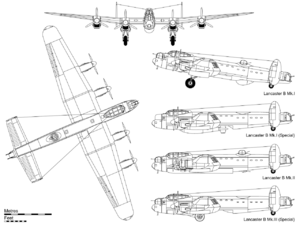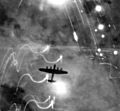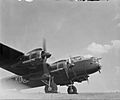Avro 683 Lancaster facts for kids
Quick facts for kids Lancaster |
|
|---|---|
 |
|
| Lancaster B I PA474 of the RAF Battle of Britain Memorial Flight in 460 Squadron (RAAF) colours, escorted by Hurricane Mk.IIc LF363. | |
| Role | Heavy bomber |
| National origin | United Kingdom |
| Manufacturer | Avro |
| Designer | Roy Chadwick |
| First flight | 9 January 1941 |
| Introduction | February 1942 |
| Status | Retired |
| Primary users | Royal Air Force Royal Canadian Air Force Royal Australian Air Force |
| Number built | 7,377 |
| Unit cost | £45–50,000 |
| Developed from | Avro Manchester |
| Variants | Avro Lancastrian |
| Developed into | Avro York Avro Lincoln |
The Avro 683 Lancaster was a very important bomber airplane used by the RAF during the Second World War. It was built in the United Kingdom by a company called Avro. This powerful aircraft was a big improvement on an earlier plane, the Avro 679 Manchester.
The main changes that made the Lancaster so successful were its four strong Rolls-Royce Merlin engines. The Manchester only had two. The Lancaster also had longer wings, which helped it fly better. These improvements made the Lancaster a much more reliable and powerful bomber. The RAF ordered many of these planes, and other companies even bought licenses to build parts for them, like Packard, which made improved engines. The most common version was the Avro 683 B I, which became the main bomber for the RAF during the war.
Contents
What Made the Lancaster Special?
The Lancaster was known for its ability to carry huge bombs. It could fly long distances and deliver its cargo with great accuracy. This made it a key part of the RAF's bombing missions during the war.
Key Features of the Lancaster B I
The Lancaster B I was a truly impressive machine for its time.
- It had a wingspan of about 31 meters (102 feet).
- The plane was about 21 meters (69 feet) long.
- It could fly at speeds up to 462 kilometers per hour (287 mph).
- The Lancaster could reach a height of 7,470 meters (24,500 feet).
- It had a long range of 4,070 kilometers (2,530 miles).
- Each Lancaster B I needed a crew of seven people to operate it.
- The plane weighed around 16,740 kilograms (36,900 pounds) when empty.
- It could take off with a maximum weight of 31,750 kilograms (70,000 pounds).
These features made the Lancaster a very effective tool during the war.
Images for kids
-
Lancaster B.I of No. 101 Squadron RAF dropping bundles of 'Window' followed by 30 lb (14 kg) incendiaries and a 4,000 lb (1,800 kg) "cookie"
-
Tallboy bombs displayed with a standard R5868 Lancaster at RAF Scampton.
-
Lancasters of No. 50 Squadron fitted with exhaust shrouds intended to conceal exhaust flames from night fighters
-
Crewman with homing pigeons, 1942. Pigeons were customarily carried aboard Lancasters as a means of communications in the event of a crash, ditching or radio failure.
-
A Lancaster being fuelled from an AEC 854 Matador truck, 1944
-
"Upkeep" bouncing bomb used for dam busting bomb mounted under Lancaster B.III (Special). The chain was driven by a hydraulic motor and gave the bomb its backspin.
-
Canadian Warplane Heritage "Mynarski Memorial" Lancaster Mk X FM213 painted as "VR-A".
See also
 In Spanish: Avro Lancaster para niños
In Spanish: Avro Lancaster para niños

























